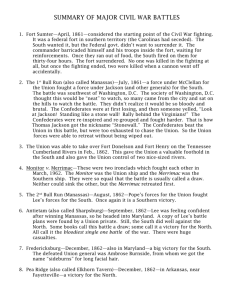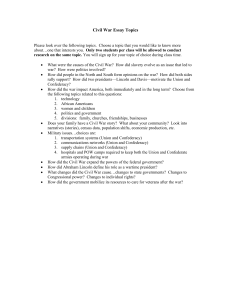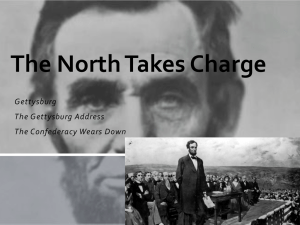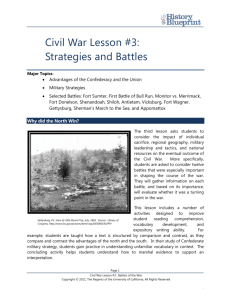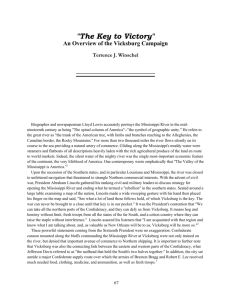Civil War Paper
advertisement
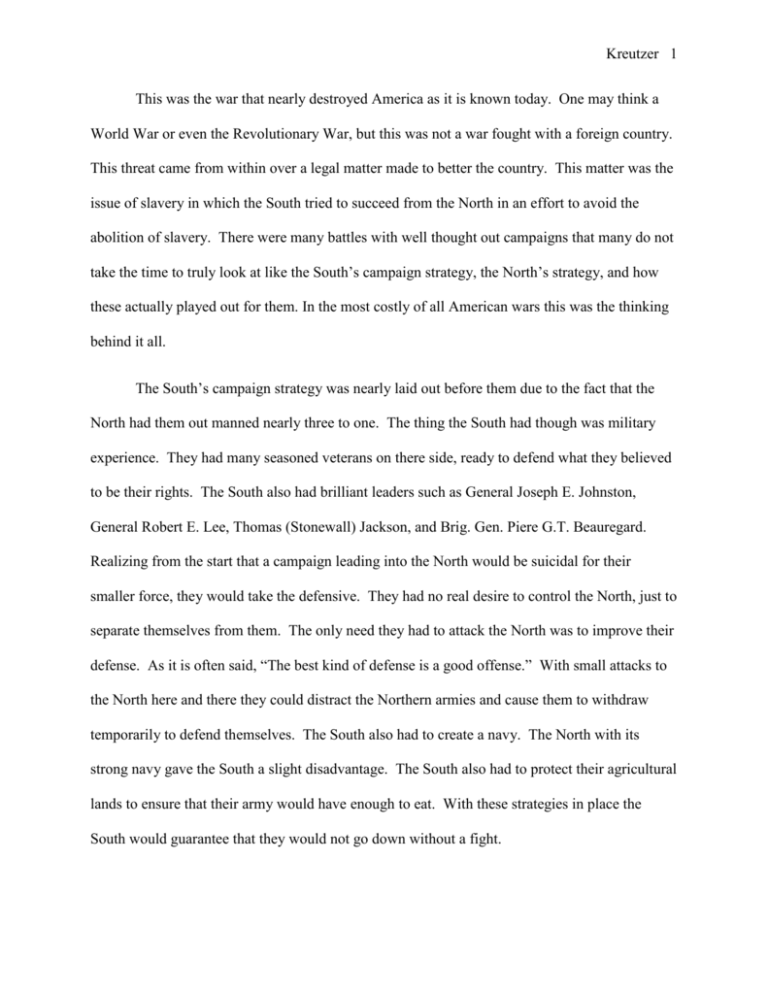
Kreutzer 1 This was the war that nearly destroyed America as it is known today. One may think a World War or even the Revolutionary War, but this was not a war fought with a foreign country. This threat came from within over a legal matter made to better the country. This matter was the issue of slavery in which the South tried to succeed from the North in an effort to avoid the abolition of slavery. There were many battles with well thought out campaigns that many do not take the time to truly look at like the South’s campaign strategy, the North’s strategy, and how these actually played out for them. In the most costly of all American wars this was the thinking behind it all. The South’s campaign strategy was nearly laid out before them due to the fact that the North had them out manned nearly three to one. The thing the South had though was military experience. They had many seasoned veterans on there side, ready to defend what they believed to be their rights. The South also had brilliant leaders such as General Joseph E. Johnston, General Robert E. Lee, Thomas (Stonewall) Jackson, and Brig. Gen. Piere G.T. Beauregard. Realizing from the start that a campaign leading into the North would be suicidal for their smaller force, they would take the defensive. They had no real desire to control the North, just to separate themselves from them. The only need they had to attack the North was to improve their defense. As it is often said, “The best kind of defense is a good offense.” With small attacks to the North here and there they could distract the Northern armies and cause them to withdraw temporarily to defend themselves. The South also had to create a navy. The North with its strong navy gave the South a slight disadvantage. The South also had to protect their agricultural lands to ensure that their army would have enough to eat. With these strategies in place the South would guarantee that they would not go down without a fight. Kreutzer 2 The North’s strategy, on the other hand, had to be based off more of a numerical scale than that of the South’s. What the North lacked for military experience, they made up for with industry, numbers, and a navy. The North, with its high industry, could easily produce the goods necessary to give their men plenty of supplies. When it came down to numbers, most of the North was highly populated cities with many young men that were more than ready to fight. Finally, the North did have a strong, well trained navy that could easily be used to block trade routes and surround the South. These all came in handy, but the South was still playing a mostly defensive war with many forts and strategic locations. The North had to attack and even with their numbers the playing field was still made even. The North had but one choice, to strike at the very heart of the confederacy, the government. From the start the plan was to head straight toward the capital and take control of it as quickly as possible. When that repeatedly failed, the best way to conquer the South was to choke them out using the navy to cut off all trade and use other army’s to take strategic locations all around and eliminate their agricultural help. On top of this was still the matter of why they were fighting in which the politics of it were still shaky for the North. They had to be careful not to loose any other states in the Union, or the war might just drag on for longer. No matter how it was looked, at the North was clearly treading in dangerous water and had to be very careful with how they handled it. Neither side could fully predict what the other was going to do, and since both halves were part of the whole greatest nation in the world, it was clear this would be no easy fight. The War officially began at 4:30 A.M. on April 12, 1861, when Confederate troops began the bombardment of Federal troops at Fort Sumter. After 34 hours of nonstop firing, Major Robert Anderson and his men had no choice but to surrender. The Confederacy now had control of the South, and after Major Anderson and his men had been evacuated, they were now ready to Kreutzer 3 defend it. Shortly afterwards, the North began its campaign to try take Richmond through a series of different campaigns. The campaign to take the capital at the start of the war was part of the Peninsular Campaign which ended in complete disaster. While the two ironclads Monitor and Merrimack were engaged in battle, Union Major General George B. McClellan took 100,000 troops from Fort Monroe and went to the town of White House, near Richmond. The indecisive Battle of Seven Pines took place on May 31-June1, and Confederate General Joseph E. Johnston was gravely wounded and Robert E. Lee took command. The Federal Army of the Potomac was then forced to retreat and Lee defeated them at the Seven Days Battles on July 1. The North then moved on to other tactics. Early on it was decided that the Mississippi offered the best path for Union forces to attack and split the Confederacy in half. After the loss of Fort Henry and Fort Donelson in February 1862, the South realized how hard it would be to defend such a wide area and evacuated Nashville, Tennessee. On April 6 and 7 the Battle of Shiloh was fought near Fort Henry at the docking point called Pittsburg Landing. This battle proved to be the largest battle in American history with over 100,000 men--1,700 of which died and 8,000 wounded-- but it opened up an import Union position which later allowed the Union to split the Confederacy. The Campaign to take Vicksburg, Mississippi, a stronghold halfway between Memphis and New Orleans, set on high bluffs with powerful batteries and a swamp to the north, was an important campaign for the Union because it would split the Confederacy in half and later proved to be one of General Grant's greatest achievements. This was not an easy campaign, taking more than a year in all. First ironclads were sent down the Mississippi to subdue Confederate batteries (MayJune 1862), then General Sherman attempted to take the city by land (December 1862), and finally Grant tried to cut a canal to divert the river from Vicksburg (February-March 1863). When all of these failed Grant made a move to get his men to higher ground behind enemy lines. Kreutzer 4 To get to this, Grant had to move his 40,000 men south to Bruinsburg, where they crossed the river with the help of Admiral David D. Porter's fleet. Grant then continued to move his army northeast, leaving their supply lines, and on May 2nd took Port Gibson, and by May 3rd they reached Grand Gulf. Here they stopped General Joseph E. Johnston and his army from going to aid Vicksburg, and forced the retreat of troops from Vicksburg, led by General John C. Pemberton, back to the city. On May 18th Grant's forces arrived at the rear of Vicksburg, where Pemberton's 30,000 troops were located, and after two failed advances, Grant strategically planned to block off all access to the city. By June, Confederate forces were running short on food and ammo, and on July 4th Pemberton surrendered the city. This surrender, combined with the victory at Gettysburg only a day before, greatly increased the moral of Union troops. Vicksburg was the last key port on the Mississippi River, which then cut all Confederate states west of it off from the rest of the Confederacy. Soon following, Petersburg, a strategic defensive position south of Richmond, was attacked by Union forces in June 1864. After many battles the Union had suffered many losses, but moral was boosted after the taking of Fort Harrison on September 29. Many important battles took place in Georgia from May to September of 1864 to cut off the South's main supply lines. Since Chattanooga, Tennessee and Vicksburg, Mississippi had already been captured by the North, Atlanta was next on the list, with its railroads, supplies, and manufacturing centers. General William Sherman also saw this as a strategic location deep inside Confederate territory that would help bring the war to a quicker end. The Confederates were led by Joseph E. Johnston, who was later replaced by Lieutenant General John Bell Hood during July. The Atlanta Campaign consisted of five months of nonstop fighting; most of these being skirmishes along with nine battles. After a few "seesaw battles," Sherman finally forced the Confederates to evacuate Atlanta on August 31 to September 1 (Atlanta). By the end of the Kreutzer 5 year Lee's forces still commanded the 2 cities, but a lack of supplies and increasing desertion were beginning to way heavily on the Confederates. After the Battle of Fort Stedman in March 1865, Lee was left with 50,000 men to Grant's 120,000. Grant then drove the Confederate forces back to inner Petersburg after the Battle of Five Forks on April 1. Lee, realizing the situation he was now in, sent word to President Jefferson Davis that they could no longer protect the cities and must evacuate. Soon after evacuation Lee's plan to unite forces with General Joseph E. Johnston was "thwarted," and Lee surrendered on April 9 (Petersburg). Finally after four years of nonstop fighting, the North had successfully taken back the South and brought the war to an end. After reviewing the South’s campaign strategy, the North’s strategy, and how it actually turned out; it is easy to see why so many were still sore about it for a while. As Mark Twain put it, the war had "uprooted institutions that were centuries old ... transformed the social life of half the country, and wrought so profoundly upon the entire national character that the influence cannot be measured short of two or three generations (American)." It may even be today that not all the sins of the war have been forgiven.
